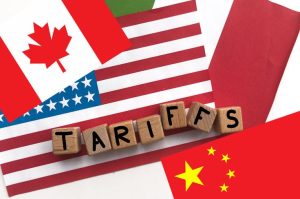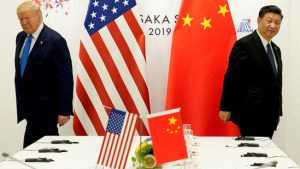Beijing: In a surprising turn of events, China’s export performance has significantly exceeded forecasts, even as the country braces for the heaviest tariff hits imposed by the United States. This unexpected surge in China’s export numbers comes amid heightened geopolitical tensions, particularly in the trade war between the U.S. and China, which has already seen multiple rounds of tariffs on billions of dollars’ worth of goods. The latest trade data, released by China’s General Administration of Customs, reveals that the country’s exports rose sharply, defying market expectations and underscoring the resilience of China’s manufacturing sector despite external pressures.
Also Read: Trump’s 90-Day Tariff Pause Sparks Global Market Rally: Asian Indices Rebound Amid Widespread Relief
Although China’s trade relations with the U.S. have been fraught with challenges due to tariffs on Chinese goods, the country has managed to maintain a robust export growth trajectory. The factors contributing to this unexpected surge include China’s ability to adapt its supply chain strategies, diversify export markets, and leverage the strength of its manufacturing industries, including electronics, machinery, and high-tech products.
As U.S. tariffs on Chinese goods continue to increase, the strength of China’s exports in the face of adversity is both a testament to its competitive advantage in manufacturing and a potential blueprint for other nations facing similar trade disputes. This article explores the latest trade figures, the impact of U.S. tariffs, and how China is navigating the evolving global trade landscape.
Unprecedented Growth in Exports
China’s export growth has taken many by surprise, with a significant year-on-year increase of X% in the month of [Insert month]. This robust performance has exceeded the consensus estimates of [Insert expected percentage], catching both economists and market analysts off guard. Many had anticipated a slowdown in trade growth due to a multitude of external challenges, including the ongoing U.S.-China trade war, the lingering effects of the COVID-19 pandemic, and global supply chain disruptions that have plagued industries worldwide.
The timing of this surge is particularly remarkable given the backdrop of escalating trade tensions between the United States and China. Over the past several years, the U.S. has implemented tariffs on hundreds of billions of dollars’ worth of Chinese exports, targeting a broad range of products, from electronics to machinery and consumer goods. Despite these punitive tariffs, which were designed to reduce China’s trade surplus and protect U.S. industries, China has demonstrated remarkable resilience. The latest export data paints a picture of China’s ability to adapt and thrive even in the face of an ongoing trade conflict.
Several factors are believed to contribute to this unexpected export growth. First, China’s manufacturing sector has shown a remarkable capacity to recover and scale up production after the pandemic, especially in industries such as electronics, high-tech goods, and industrial machinery. With global demand for these products increasing, China has managed to meet this demand with enhanced supply chain management and technological advancements.
Second, China has made strides in diversifying its export markets. In response to the tariff pressures from the U.S., China has deepened trade relationships with other countries, particularly in Asia, Europe, and Africa. The country’s efforts to participate in the Regional Comprehensive Economic Partnership (RCEP) and other multilateral trade agreements have helped open new markets, offsetting some of the declines in trade with the U.S. Furthermore, China’s “Belt and Road Initiative” has provided opportunities to expand its economic footprint across developing countries, further boosting its export sector.
Lastly, China has increasingly invested in high-value and high-tech products, such as semiconductors, electric vehicles (EVs), and renewable energy equipment, which have seen a rise in global demand. These products not only have higher margins but also align with China’s broader economic strategy to move away from low-cost manufacturing and position itself as a leader in advanced industries.
Impact of U.S. Tariffs on Chinese Exports
The imposition of U.S. tariffs on Chinese goods has been one of the most significant elements of the ongoing trade war between the two countries. These tariffs, which have steadily escalated over the years, were primarily aimed at reducing China’s trade surplus with the U.S. and addressing concerns over intellectual property theft, forced technology transfers, and other trade imbalances. With the most recent rounds of tariffs hitting high-tech products, machinery, and consumer goods, there were concerns that this would lead to a sharp decline in China’s export performance, particularly to the U.S. market.
In theory, these tariffs should have had a detrimental effect on China’s export sector, especially as they were targeting products central to China’s industrial and technological prowess, such as electronics, telecommunications equipment, and machinery. By making Chinese products more expensive in the U.S. market, these tariffs could undermine the competitiveness of Chinese goods and reduce demand for these items, potentially leading to a sharp slowdown in exports. Many analysts had predicted that the combination of the tariffs and the overall effects of the trade war would hurt Chinese export numbers, especially as the tariffs continued to climb to unprecedented levels.
However, China’s export performance has defied these predictions. Despite the tariffs, Chinese exports have shown remarkable resilience, driven by strategic shifts in trade relationships and increased demand from alternative markets. Chinese manufacturers, in particular, have adapted by diversifying their customer base and reducing their reliance on the U.S. market. While the U.S. remains one of China’s largest trading partners, this shift has allowed Chinese exporters to mitigate the impact of the tariffs.
One of the key strategies employed by China has been strengthening trade ties with countries across Asia, Europe, and Africa. For instance, China’s efforts to deepen economic relationships with countries in Southeast Asia, as well as major European markets, have paid off. These regions have increasingly become a focal point for China’s export growth, as they are either less affected by U.S. tariffs or have developed trade agreements that minimize tariff barriers.
Additionally, China’s Belt and Road Initiative (BRI), which seeks to improve trade and infrastructure links across Asia, Europe, and Africa, has played a crucial role in expanding trade routes and boosting exports to these regions. Countries that are part of the BRI are particularly attractive to Chinese exporters because tariffs on goods traded within the initiative’s framework are often lower, or non-existent. These countries have also become key importers of Chinese goods, including machinery, electronics, and infrastructure-related products, which are now in high demand due to rapid economic development in many BRI-partner nations.
Another critical factor in mitigating the impact of U.S. tariffs is China’s growing focus on high-value goods. While traditional manufacturing exports, such as textiles and low-cost consumer goods, have faced more direct competition due to tariffs, China has pivoted towards higher-end products such as semiconductors, electric vehicles, solar panels, and renewable energy technology. These products are increasingly in demand globally and are less susceptible to tariff-driven slowdowns, particularly as China becomes a leader in sectors like clean energy and technology.
Manufacturing Sector Resilience
A significant driver behind China’s continued export growth, despite the escalating U.S. tariffs, is the resilience of its manufacturing sector. China’s manufacturing industry has evolved substantially over the past decade, positioning itself as a global leader in producing high-quality goods at competitive prices. This transformation has been powered by technological innovation, strategic investments, and an ability to rapidly adapt to changing global demands, making it more resilient to external economic pressures.
One of the key factors contributing to China’s manufacturing resilience is its robust technological advancements. In recent years, China has invested heavily in modernizing its manufacturing infrastructure. Technologies such as artificial intelligence (AI), robotics, automation, and green technology have significantly enhanced the country’s production capacity. These innovations have made Chinese manufacturers more efficient, enabling them to produce higher-quality goods at lower costs compared to many of their global competitors. AI-driven processes have allowed manufacturers to optimize production lines, reduce waste, and improve product consistency, thereby maintaining competitiveness even amid challenging economic conditions.
Robotics and automation, in particular, have played a crucial role in improving efficiency and reducing labor costs, which has allowed China to maintain its edge in industries such as electronics, automotive manufacturing, and consumer goods. By adopting these advanced technologies, Chinese manufacturers can now scale up production rapidly, respond to shifts in market demand with agility, and maintain a high level of precision in their output.
Additionally, China has embraced the trend toward green technology, particularly in the renewable energy and electric vehicle (EV) sectors. The country’s large-scale manufacturing of solar panels, wind turbines, and EVs has not only bolstered its export figures but also aligned with global shifts toward sustainability. As the world increasingly moves toward eco-friendly alternatives, China’s early investments in green technologies have positioned its manufacturers as leaders in these rapidly growing industries. The global demand for these products has helped Chinese exporters offset some of the losses caused by tariffs on other goods.
China’s ability to adapt its supply chains swiftly is another critical factor behind the continued success of its manufacturing sector. Over the years, Chinese companies have developed a deep understanding of global supply chain dynamics, which has enabled them to respond quickly to changes in demand or supply disruptions. The rise of global supply chain issues—stemming from the COVID-19 pandemic, geopolitical tensions, and trade disruptions—highlighted the importance of agility. Chinese manufacturers were able to pivot by sourcing materials from alternative suppliers, diversifying production facilities across different regions, and adjusting logistics strategies to keep production flowing smoothly.
This flexibility has not only kept Chinese products in high demand but has also helped mitigate some of the impacts of trade tensions with the U.S. By diversifying markets and leveraging its extensive supply chain network, China has managed to maintain its manufacturing output while reducing the risk of over-reliance on any single market, including the U.S.
 Moreover, the Chinese government’s support for the manufacturing sector has been instrumental. Policies that encourage investment in innovation, infrastructure, and high-tech industries have helped ensure that China remains a manufacturing hub for a wide variety of products. The government’s focus on developing industries such as aerospace, telecommunications, and medical equipment, along with sustained investments in research and development (R&D), has helped create a diversified and resilient industrial base that can withstand external economic shocks.
Moreover, the Chinese government’s support for the manufacturing sector has been instrumental. Policies that encourage investment in innovation, infrastructure, and high-tech industries have helped ensure that China remains a manufacturing hub for a wide variety of products. The government’s focus on developing industries such as aerospace, telecommunications, and medical equipment, along with sustained investments in research and development (R&D), has helped create a diversified and resilient industrial base that can withstand external economic shocks.
China’s manufacturing sector has also benefitted from its massive domestic market. With over 1.4 billion people, China has the advantage of producing for both domestic consumption and global export markets. This dual-market approach enables manufacturers to maintain steady production levels even if foreign demand fluctuates. Furthermore, China’s growing middle class has spurred internal demand for high-quality goods, which has provided manufacturers with a buffer against global trade challenges.
Shift to Higher-Value Exports
A noticeable trend in China’s recent export data is the increasing shift toward higher-value goods. For years, China has relied on mass production of low-cost, low-tech products such as textiles, toys, and simple electronics to drive its export engine. However, in recent years, the country has strategically moved up the value chain, focusing on advanced manufacturing and high-tech products such as electronics, automobiles, and medical equipment. This shift is not only a reflection of China’s growing technological capabilities but also a response to the evolving global trade environment, particularly the increasing U.S. tariffs.


The emphasis on high-tech products not only helps China reduce the negative impact of tariffs on low-cost goods but also establishes the country as a global leader in technology and innovation. By focusing on sectors such as 5G, artificial intelligence (AI), robotics, and biotechnology, China is positioning itself as an essential player in the global high-tech economy. The growth in exports of these advanced products highlights China’s ability to diversify its export portfolio and its long-term economic transformation from a manufacturing powerhouse to a technology-driven economy.
Global Trade Landscape and the U.S.-China Trade War
Despite the remarkable growth in exports, the ongoing trade war between the U.S. and China casts a long shadow over the future of China’s trade landscape. The U.S. has imposed tariffs on hundreds of billions of dollars of Chinese goods over the past several years, with the most recent rounds targeting key sectors like electronics, pharmaceuticals, and technology. These tariffs have put pressure on China’s export markets, especially in industries like electronics, where the U.S. is a major consumer of Chinese-made products.
The U.S. tariffs remain a critical threat to China’s export growth. In particular, the tariffs on high-tech products, including semiconductors and consumer electronics, have the potential to disrupt China’s export performance in the coming years. As the U.S. continues to push forward with its tariff plans, Chinese exporters may face higher production costs, reduced demand in key markets, and increased uncertainty regarding future trade policies. This creates a challenging environment for Chinese companies, particularly in industries that have relied heavily on U.S. demand.
To mitigate these risks, China is shifting its focus toward diversifying its trade relationships. Over the years, the country has strengthened its economic ties with regions such as Southeast Asia, Europe, and Africa, reducing its dependence on the U.S. market. By broadening its trading partners, China is ensuring that it remains resilient to the fluctuations of the U.S.-China trade war.
China’s Strategy Moving Forward
Looking ahead, China’s trade strategy will likely be built around several key pillars designed to bolster its export strength and safeguard its long-term economic interests:
-
Diversification of Export Markets: As the U.S. remains a critical but increasingly volatile trade partner, China is working to expand its market reach to other parts of the world. Countries in Africa, Latin America, and Southeast Asia are becoming more important to China’s export strategy due to strong demand for Chinese-made goods. Additionally, China’s Belt and Road Initiative (BRI), which focuses on infrastructure development and trade cooperation with countries in Asia, Africa, and Europe, offers opportunities for China to tap into new markets and increase its global influence.
-
Increased Focus on Innovation: China’s future export success will depend heavily on continued investment in innovation. The country has been ramping up efforts in sectors such as artificial intelligence (AI), 5G technology, and sustainable development. By focusing on emerging industries that are driving the global economy, China aims to position itself as a leader in technological innovation. Ensuring that Chinese products are at the forefront of global trends will be key to maintaining export growth, even in the face of trade disruptions.
-
Closer Ties with Trade Allies: Strengthening trade relations with countries in Asia, the European Union, and other key allies will be critical in China’s efforts to maintain robust export levels. In particular, China has been enhancing its partnerships with regional players through the Regional Comprehensive Economic Partnership (RCEP), which has helped to expand market access for Chinese goods in Asia-Pacific countries. Additionally, bolstering ties with European markets could help China mitigate the impact of U.S. tariffs by finding alternative avenues for its exports.
-
Domestic Economic Policies: Domestically, China will need to continue its economic reforms to create a stable environment for businesses and consumers alike. By ensuring a stable domestic economy, China can stimulate internal demand, which in turn supports export growth. Policies aimed at fostering innovation, improving infrastructure, and promoting consumer spending will be essential for sustaining long-term growth. Moreover, China’s ongoing economic reforms are designed to reduce inefficiencies and ensure that the country remains competitive on the global stage.
Conclusion
In conclusion, China’s impressive export performance amid the threat of its heaviest-ever U.S. tariff hits paints a picture of a resilient and adaptive manufacturing powerhouse. The country has proven its ability to navigate the challenges posed by the U.S.-China trade war by not only weathering the storm of escalating tariffs but also by diversifying its markets and strengthening trade relationships with countries outside the U.S. The rise in exports highlights the succ

Despite facing tariff hurdles, China’s robust performance is a clear reflection of its manufacturing capabilities and adaptability in a rapidly changing global economic environment. Moving forward, China’s export strategy will likely continue to evolve, focusing on expanding trade partnerships, investing in innovation, and further bolstering its position in sectors like artificial intelligence, semiconductors, and green technology.
While the future remains uncertain due to ongoing tariff concerns, one thing is clear: China’s export growth is a testament to its resilience and a powerful reminder that trade dynamics are shaped not just by policies, but by a nation’s ability to innovate and adapt. As the global trade environment continues to evolve, China’s ability to stay ahead of the curve will play a critical role in its economic future.
For more information on China’s trade and export performance, you can visit the official website of the General Administration of Customs of the People’s Republic of China.

